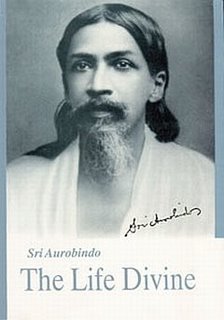 |
ADAM AND EVE: THE CONSCIOUSNESS VIEW
From Unity to Multiplicity
The Reality which is a triune of Existence-Consciousness-Bliss (Sachchidananda) is a UNITY-principle, which can also be referred to as the ‘unitary’ principle. This principle is self-contained, absolute, beyond space and time and exists regardless of whether the creation subsists or is dissolved.
The very concept of Creation implies a manifestation that expresses itself through multiplicity. To express and support this multiplicity, the unitary principle gets dissociated and its three poises - Existence, Consciousness, and Bliss - get de-linked from each other. This movement culminates in each poise getting divided and subdivided, albeit endlessly.
Naturally, once initiated, this self-propelled movement of division and subdivision has to go on, till all potentialities, probabilities, possibilities get a chance of being expressed, worked out and fulfilled.
|
|
It is noteworthy that theoretically, if all possibilities have to be
worked out, principles, which appear to have ‘negative’
connotations, have as equal a chance of getting manifested as
principles that appear to be of ‘positive’ value to
the human psyche. For example, if an accountant of a firm is allowed to develop his accounting skills, he can, per se, also develop skills of manipulation, cheating and dishonesty. If a ruler of a nation is given full freedom of work, he can also end up by becoming a merciless dictator.
This is exactly what happens in the play of creation. Originally, the Unity-principle or the unitary principle manifested in basic modalities, gives rise to
-- ‘Self’ as the essence of existence
-- ‘Beauty’ as forms of existence
-- ‘Light & Knowledge’ as essence of consciousness
-- ‘Will, Volition’ as force of consciousness
-- ‘Love, Happiness’ as values of Bliss,
-- ‘Joy, Ananda, Delight, Peace, and Harmony’ as essence of Bliss
With the ‘Multiplicity principle’ activated in creation, all these modalities developed also their polar opposites leading to
Death,
Disharmony,
Entropy,
Ignorance,
Falsehood,
Inertia,
Pain,
Hatred,
Suffering, and
Inconscience
Thus, the ‘unitary’ Sachchidananda principle gets expressed through a world of dualities.
It is in this context that Sri Aurobindo explains the parable of Adam and Eve as follows:
THIS IS THE FALL OF MAN TYPIFIED IN THE POETIC PARABLE OF THE HEBREW GENESIS.THAT FALL IS HIS DEVIATION FROM THE FULL AND PURE ACCEPTANCE OF GOD AND HIMSELF, OR RATHER OF GOD IN HIMSELF, INTO A DIVIDING CONSCIOUSNESS WHICH BRINGS WITH IT ALL THE TRAIN OF THE DUALITIES, LIFE AND DEATH, GOOD AND EVIL, JOY AND PAIN, COMPLETENESS AND WANT, THE FRUIT OF A DIVIDED BEING.THIS IS THE FRUIT WHICH ADAM AND EVE, PURUSHA AND PRAKRITI, THE SOUL TEMPTED BY NATURE HAVE EATEN.
(The Life Divine, pg.58)
Sri Aurobindo therefore does not examine the parable of Adam and Eve from the standpoint of morality or virtues. He examines it purely from the consciousness perspective and does not draw conclusions from oversimplifications. The fall of Man is the price that has to be paid when the unitary consciousness loosens its cohesiveness in its plunge into the world of multiplicity. Sri Aurobindo is actually more concerned with the technique of redemption.
The redemption
It is agreed in spiritual tradition that the redemption has to be a reconstruction of the unitary principle. One way of doing it would be to reject the world of dualities or multiplicity as a ‘falsehood or ‘sin’ or ‘delusion’ or ‘Maya’ while regarding the experiential contact with Sachchidananda as the sole pursuit worth navigating in the realms of consciousness. But Sri Aurobindo wants to reconstruct the unitary principle in the world of dualities, within the framework of multiplicity, and in the matrix of creation. A unity devoid of the multiplicity or a unity that denies the multiplicity is a blank, featureless unity. A unity that includes in its bosom the essence of multiplicity is a vibrant, pulsating, fulfilling, meaningful and creative unity.
Sri Aurobindo answers that the redemption is possible because what we ordinarily consider as the negative attributes have themselves manifested from the Sachchidananda:
“IF ALL is in truth Sachchidananda, death, suffering, evil, limitation can only be the creations, positive in practical effect, negative in essence, of a distorting consciousness which has fallen from the total and unifying knowledge of itself into some error of division and partial experience…..
THE REDEMPTION COMES BY THE RECOVERY OF THE UNIVERSAL IN THE INDIVIDUAL AND OF THE SPIRITUAL TERM IN THE PHYSICAL CONSCIOUSNESS. Then alone the soul in Nature can be allowed to partake of the fruit of the tree of life and be as the Divine and live forever.” (Ibid, pg 58)
The Life Divine justifies how the discordant elements can be reconciled into the image of the divine Unity. Interestingly, what happens is something more than a mere reconciliation: for the discordant elements, prior to reconciliation, need to be transfigured into higher terms through a process of transcendence.
“Transcendence transfigures; it does not reconcile, but rather transmutes opposites into something surpassing them that effaces their oppositions’ (Ibid, pg 59)
The Iron Dictators
I looked for Thee alone, but met my glance
The iron dreadful Four who rule our breath,
Masters of falsehood, Kings of ignorance,
High sovereign Lords of suffering and death.
Whence came these formidable autarchies,
From what inconscient blind Infinity, -
Cold propagandists of a million lies,
Dictators of a world of agony?
Or was it Thou who bor’st the fourfold mask?
Enveloping Thy timeless heart in Time,
Thou hast bound the spirit to its cosmic task,
To find Thee veiled in this tremendous mime.
Thou, only Thou, canst raise the invincible siege,
O Light, O deathless Joy, O rapturous Peace!
(Sri Aurobindo,
Collected Poems, pg 166)
Date of Update:
18-Nov-11
- By Dr. Soumitra Basu
|

